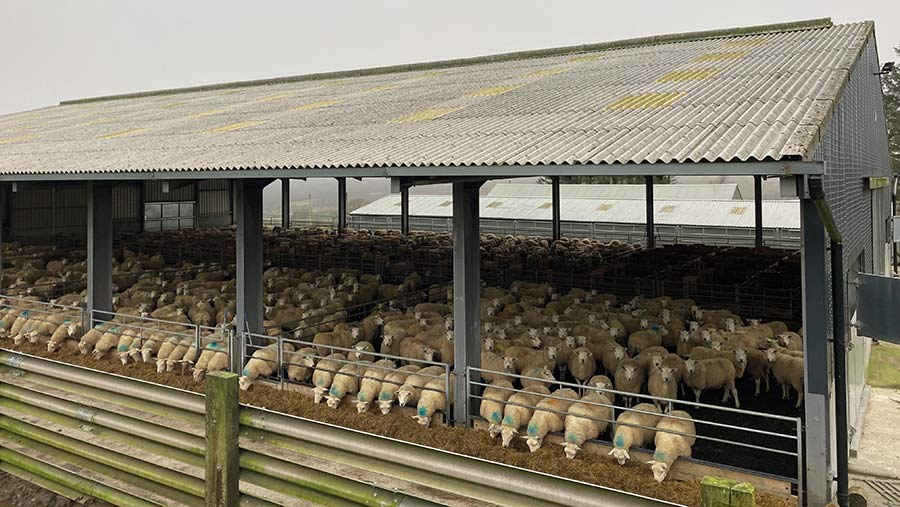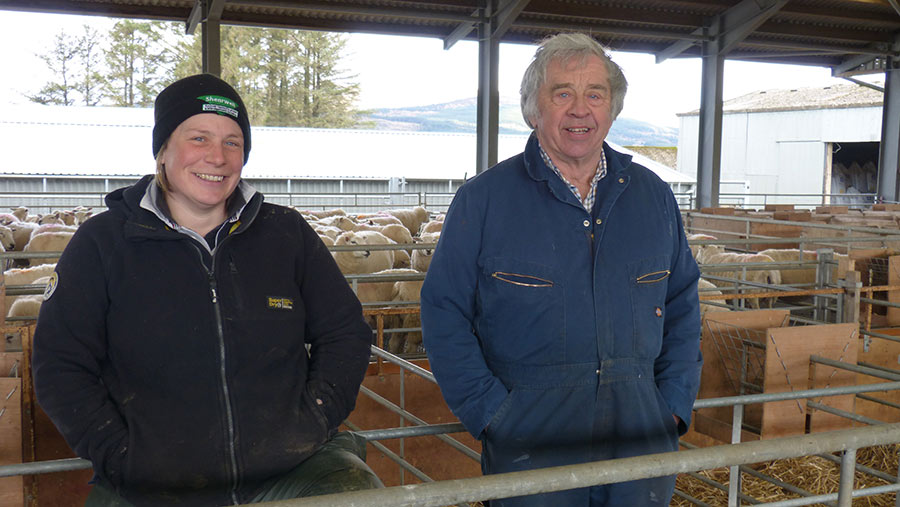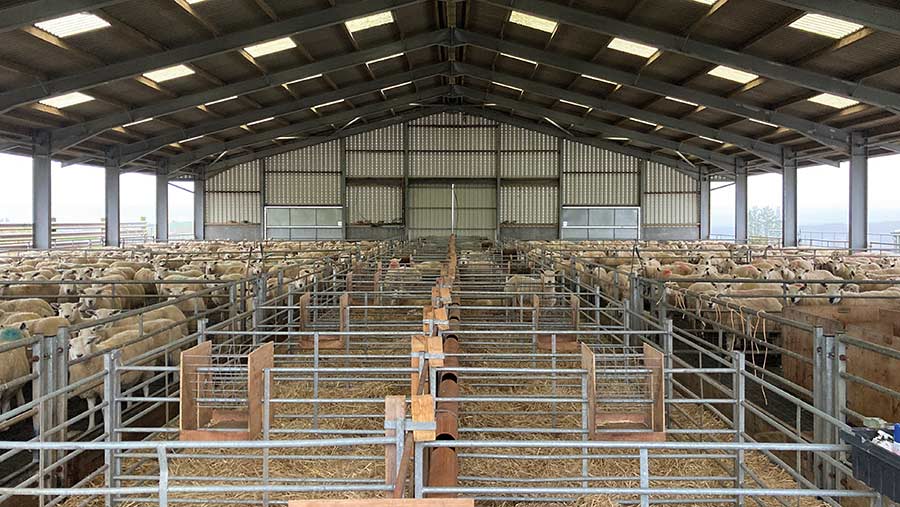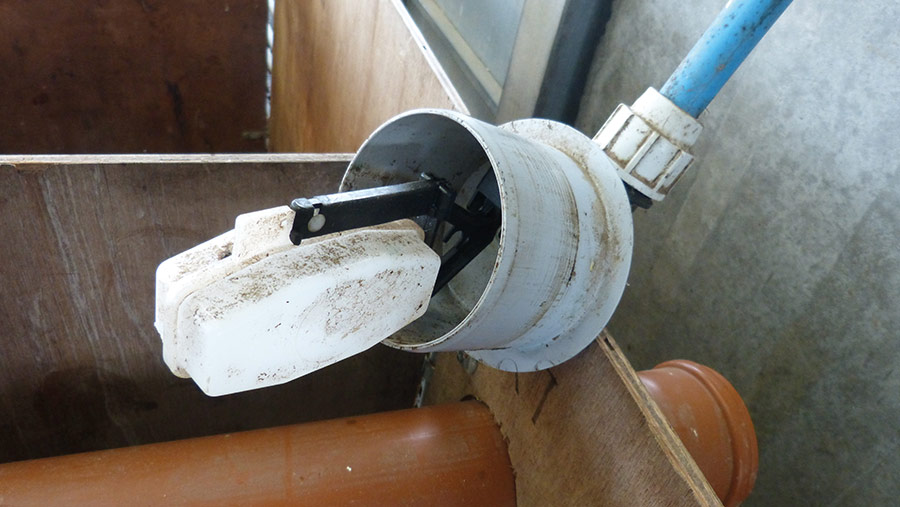Slatted sheep shed builds resilience into upland farm
 © Hilary Howatson
© Hilary Howatson Investing in a slatted sheep house has enabled a Scottish upland sheep and beef farm to see the full effect of a breed change, while controlling labour and input costs.
The Howatsons have lambed the Lleyn portion of their flock indoors at Risk Farm, Newton Stewart for seven years. Prior to that, everything was lambed outside.
But thanks to a slatted shed, finished in the spring of 2015, the farm has seen rearing rates lift, labour cost fall, and only a negligible lift in straw spend.
See also: What’s In Your Livestock Shed: £5k sheep shed transformation
Farm facts: Risk Farm
- 2,200ha (5,436 acres) mostly rough grazing and unimproved pasture
- 1,000 Lleyn ewes and 600 Scottish Blackface ewes
- 60ha (150 acres) of silage ground and 80ha of better in-bye ground
- Lleyn tups used to breed replacements
- Abermax terminal sires
- 390 Salers and Salers-cross cows
- Prime lambs sold at Newton Stewart market
- Land rises from sea level to over 700m
- 1.27-1.52m of precipitation/year
- 15kw wind turbine
Previous system
Historically, the Howatsons ran 2,000 Scottish Blackface ewes, lambing everything outside.
About 1,000 ewes were crossed to a traditional-type Bluefaced Leicester to sell breeding lambs at Castle Douglas and the rest were bred pure for replacements and the prime and store market.
However, the upland weather systems and proximity to the Galloway Forest meant mortality could be high owing to fox and corvid predation. The tough ground meant the farm was limited to selling lower-value running lambs.
Change to Lleyn
Back in 2006, Alan, who farms with daughter Hilary and son John, experimented with Lleyns.
He thought the breed’s hardiness and maternal ability could be a good fit for the ground the family farmed.
The relatively high number of high-health Lleyn flocks meant that sheep could be bought in with little disease risk. Some sheep were bought from the Cursiters on Orkney.
“This is a rough farm – the small amount of ground we can reseed is done with a digger in the field to remove stone,” explains Alan. “To ensure the Lleyns could cope, I mixed in some with a group of Blackies and they held condition and managed fine without needing extra feeding.”

Hilary and her father Alan have seen a range of savings since building the slatted sheep house © Hilary Howatson
Shed routine
Lleyns lamb from 1 April, with about 80% lambing in the first 10 days and only 40 or 50 lambing on the second cycle. The 600 Blackfaces start lambing outside on 25 April.
Tup raddles are changed every 10 days on the Lleyns, which helps house sheep that are close to lambing.
Any lame ewes are jabbed, foot-bathed, and put back to grass again for a few days to allow their feet to heal before being housed on the slats.
Slatted shed facts
- First used for lambing in 2015
- Dimensions: 36.5m x 24.34m with 1.21m roof overhang
- 4.2m central concrete feed passage
- 146m of feedspace (inside and outside)
- Rough cost: £30,000 for steel tank and plastic Rimco slats and £30,000 for rest of the shed
- Septic tank holds four year’s dung
- Expected to last 30 years before major refurbishment
Singles and twins are housed in the slatted shed. Triplets (100-130) are housed in an old building next door and Hilary takes lambs up into the slatted shed to foster on.
The farm is Quality Meat Scotland assured, so bedding must be provided for newborn and young lambs. There are 54 straw-bedded pens on the central concrete feed passage, which sheep lamb in.
Clean drinking water is supplied to the ewes through push drinkers when on slatted yards. Water is supplied by an automatic drinking system constructed from pipes supplied by a stopcock for sheep in pens.
A drinking hole is cut into the pipe which runs between two lines of pens, meaning one drinker supplies two ewes, explains Hilary.
The plastic slats are disinfected with a Defra-approved disinfectant via a knapsack sprayer halfway through lambing to prevent the build-up of pathogens.
Before they leave the shed, lambs have their navels dipped in iodine. They are then marked, vaccinated for orf, tailed and castrated.
Lambs are usually inside for only 24-48 hours. Ewes and lambs are taken out to pasture in a quad bike trailer.

Homemade hayracks and a plastic pipe drinker system supply 54 straw-bedded pens in the central feed passage of the shed © Hilary Howatson
Shed feeding
Housing the ewes fits in well with the cattle enterprise, as the sheep can share the Keenan forage wagon. Each year silage is analysed, and a cost-effective energy source bought in to feed the sheep.
Last year, a mix of barley and beet pulp was used. This year, 0.6kg/day of an 18% crude protein beet pulp cob was fed to the twins and singles, with silage supplied ad-lib and sheep eating to their own appetite.
The silage is chopped to a length of about 20-22mm and well mixed. Sheep are fed as and when forage needs replacing.
Home-made hay racks supply two pens each and include a catch tray for concentrate feed. Hay making has become too difficult in the wet climate, so is all bought in.
As well as the feeder wagon passing along the outside of the shed, Hilary fills 20-litre plastic tubs from the feeder wagon and feeds ewes alongside the two internal feed barriers.

Plastic pipes automatically refill by a stopcock system, saving labour and buckets © Hilary Howatson
Shed benefits
With the help of indoor lambing and lower newborn lamb loss, the Lleyns typically rear 155% or more after scanning at 164-168%. This compares to the Blackfaces, which scan at about 150% and rear 130% outside.
The shed can be bedded with 1.5 Hesston bales, and requires only five or six for lambing.
Because relatively small amounts of straw and hay are used by the sheep, it can be bought and stockpiled in cheaper years.
Less time spent bedding and mucking out means the farm can lamb with two lambers, as opposed to three when lambing was outside. The farm’s labour consists of John, Hilary and Alan (who is retiring soon), a full-time farm hand, and a lamber for three weeks each spring.
At other times of the year, sheep can be housed on slats at short notice before shearing or cull ewe sales.
Ewe lambs can be wintered in the shed to rest pasture and more than 1,000 wethers can be housed for finishing, while longer-term lambs are stored on kale.
Housing lambs keeps them dry and shortens finishing times. The farm used to sell 20% of its wethers in the spring as stores, but can now sell all of these as prime lambs.
Furthermore, the white-faced Abermax cross Lleyns make £6-£8 a head more than Mule wethers, says Alan.
The slatted shed is an attraction for lambers looking for seasonal work as it’s an efficient and pleasant place to lamb in. It is well ventilated and has electric lighting for the night check.
“It’s hard to justify a shed like that for sheep,” says Alan. “However, it’s more efficient, makes running the farm easier and saves on labour, which is harder to find than ever.”
